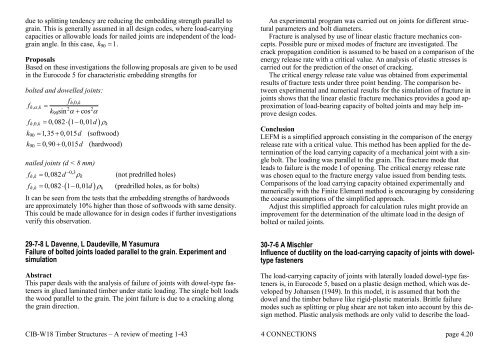Download pdf - CIB-W18
Download pdf - CIB-W18
Download pdf - CIB-W18
- TAGS
- download
- cib-w18.com
You also want an ePaper? Increase the reach of your titles
YUMPU automatically turns print PDFs into web optimized ePapers that Google loves.
due to splitting tendency are reducing the embedding strength parallel to<br />
grain. This is generally assumed in all design codes, where load-carrying<br />
capacities or allowable loads for nailed joints are independent of the loadgrain<br />
angle. In this case, k90 � 1.<br />
Proposals<br />
Based on these investigations the following proposals are given to be used<br />
in the Eurocode 5 for characteristic embedding strengths for<br />
bolted and dowelled joints:<br />
f<br />
h,0, k<br />
h, � , k �<br />
2 2<br />
k90sin<br />
� cos<br />
� �<br />
f � 0,082� 1� 0,01d<br />
h,0, k k<br />
k �1,35 �0,015<br />
d (softwood)<br />
90<br />
k �0,90 �0,015<br />
d (hardwood)<br />
90<br />
f<br />
� �<br />
nailed joints (d < 8 mm)<br />
�0,3<br />
h, k � �k<br />
� �<br />
h, k k<br />
�<br />
f 0,082 d<br />
(not predrilled holes)<br />
f � 0,082 � 1� 0,01 d � (predrilled holes, as for bolts)<br />
It can be seen from the tests that the embedding strengths of hardwoods<br />
are approximately 10% higher than those of softwoods with same density.<br />
This could be made allowance for in design codes if further investigations<br />
verify this observation.<br />
29-7-8 L Davenne, L Daudeville, M Yasumura<br />
Failure of bolted joints loaded parallel to the grain. Experiment and<br />
simulation<br />
Abstract<br />
This paper deals with the analysis of failure of joints with dowel-type fasteners<br />
in glued laminated timber under static loading. The single bolt loads<br />
the wood parallel to the grain. The joint failure is due to a cracking along<br />
the grain direction.<br />
An experimental program was carried out on joints for different structural<br />
parameters and bolt diameters.<br />
Fracture is analysed by use of linear elastic fracture mechanics concepts.<br />
Possible pure or mixed modes of fracture are investigated. The<br />
crack propagation condition is assumed to be based on a comparison of the<br />
energy release rate with a critical value. An analysis of elastic stresses is<br />
carried out for the prediction of the onset of cracking.<br />
The critical energy release rate value was obtained from experimental<br />
results of fracture tests under three point bending. The comparison between<br />
experimental and numerical results for the simulation of fracture in<br />
joints shows that the linear elastic fracture mechanics provides a good approximation<br />
of load-bearing capacity of bolted joints and may help improve<br />
design codes.<br />
Conclusion<br />
LEFM is a simplified approach consisting in the comparison of the energy<br />
release rate with a critical value. This method has been applied for the determination<br />
of the load carrying capacity of a mechanical joint with a single<br />
bolt. The loading was parallel to the grain. The fracture mode that<br />
leads to failure is the mode I of opening. The critical energy release rate<br />
was chosen equal to the fracture energy value issued from bending tests.<br />
Comparisons of the load carrying capacity obtained experimentally and<br />
numerically with the Finite Element method is encouraging by considering<br />
the coarse assumptions of the simplified approach.<br />
Adjust this simplified approach for calculation rules might provide an<br />
improvement for the determination of the ultimate load in the design of<br />
bolted or nailed joints.<br />
30-7-6 A Mischler<br />
Influence of ductility on the load-carrying capacity of joints with doweltype<br />
fasteners<br />
The load-carrying capacity of joints with laterally loaded dowel-type fasteners<br />
is, in Eurocode 5, based on a plastic design method, which was developed<br />
by Johansen (1949). In this model, it is assumed that both the<br />
dowel and the timber behave like rigid-plastic materials. Brittle failure<br />
modes such as splitting or plug shear are not taken into account by this design<br />
method. Plastic analysis methods are only valid to describe the load-<br />
<strong>CIB</strong>-<strong>W18</strong> Timber Structures – A review of meeting 1-43 4 CONNECTIONS page 4.20














